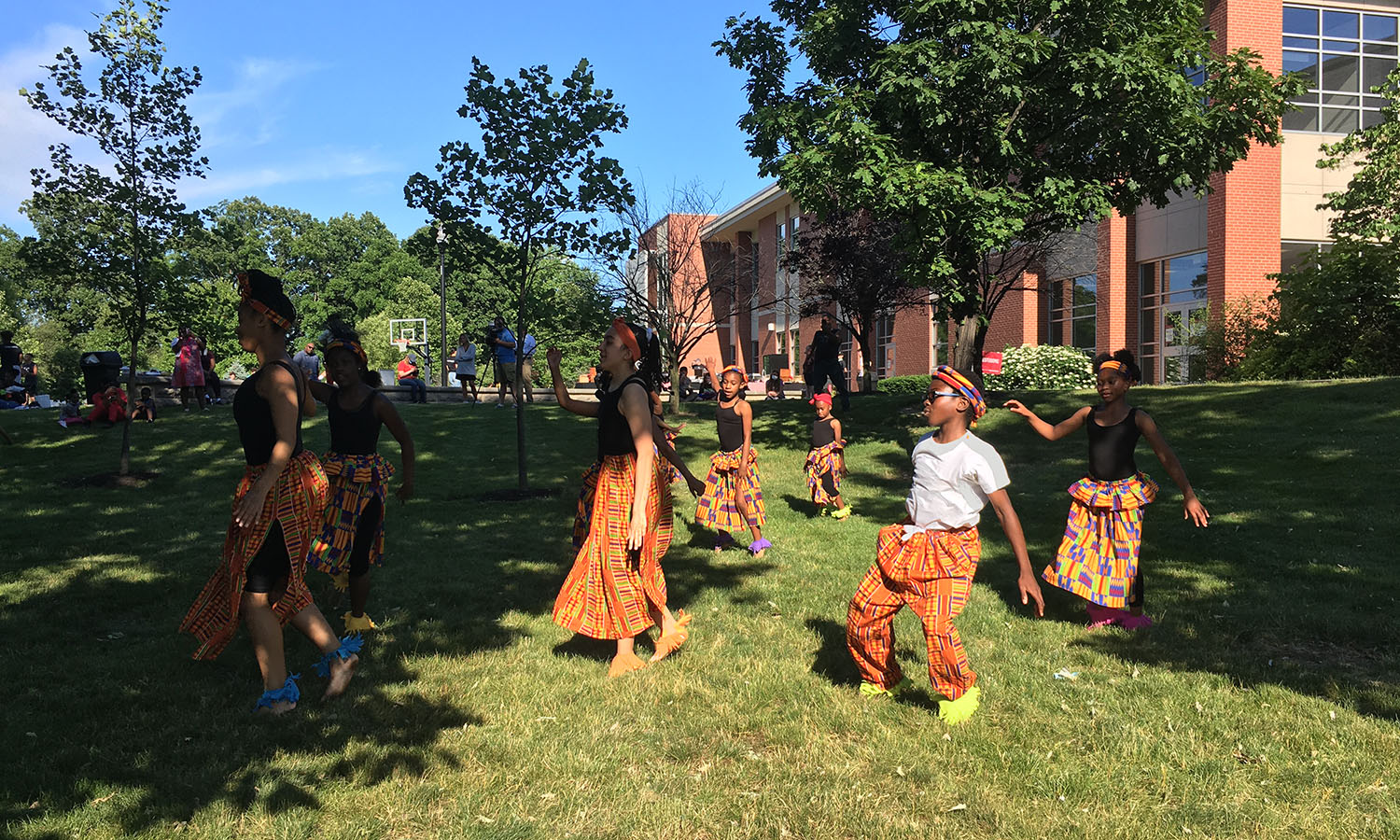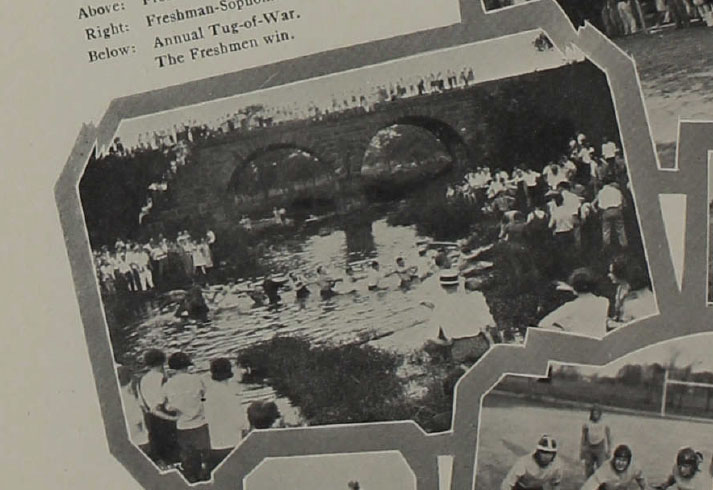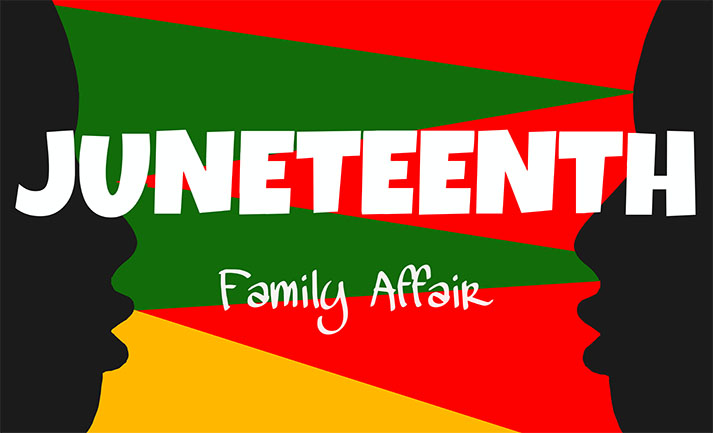Mission Matters #72: Celebrating Juneteenth Traditions at UIndy

By Dr. Michael G. Cartwright
Vice President for University Mission and Associate Professor of Philosophy & Religion
Recognizing the Contributions of the OIE Inclusive Excellence Strategic Leadership Coalition – Juneteenth Celebration June 17, 2021
It is my privilege to pay tribute to the good work that more than 40 people have done this past year as part of the Office of Inclusion & Equity’s Strategic Leadership Coalition (see list of names at the end of this essay).
Sometimes, it can be difficult to register the significance of collective contributions, particularly when we are talking about the origins of traditions at a comprehensive university like ours. I want to take you back in time almost a century ago when faculty, staff, and students were quite literally inventing university traditions that have contributed to our campus ethos. To help, I want to call your attention to a couple of artifacts from the University’s archives.
One of my favorite artifacts is a resolution passed by “the student body” that established a friendly competition that would continue in one form or another for more than seven decades before it faded away along with the “Brown County Day” event in 2001.

You may have heard of it. The annual “Tug-of-War” between the sophomore class and the first-year students. The time: The second Friday of the fall semester. The location: Lick Creek. (This requires some translation given that most of us don’t have occasion to travel over to Longacre Park, but if you turn left on Lick Creek Parkway in the 4700 block of Madison Avenue just after passing over I-465, you can still see the body of water adjacent to the railroad tracks where the earliest tug of wars took place.)
Part of what I find remarkable about this document is the fact that the students were so deliberate in creating something that was also quite a lot of fun. (That is something that we should keep in mind, I think, as we continue to create our Juneteenth traditions.)
Indiana Central students in the 1920s understood well that they were participating in already existing traditions (i.e., the rivalry between classes in the lower division of the undergraduate college). And they also were confidently building on the past while shaping future practices.
To that end, they indicated that the Tug of War should “uphold the highest ideals” of the university. There would be no hazing. (In those days, the University was explicit in its rejection of fraternities and sororities out of a strong desire to be egalitarian. No one was to lord it over others.)
At the same time, the student leaders thought there was nothing wrong with having bragging rights over their classmates. Indeed, the students were joining with the faculty by setting forth the guidelines within which undergraduates could participate in the tug-of-war without things getting out of hand.
The first provision governing the competition was stated this way. “Contestants shall be half the number of male members of the sophomore class opposed by an equal number of freshmen. The contestants are to be chosen by the respective classes.” Notice, this provision reflected the scale of an institution in which the total number of students was around 250. So we are talking about 30 persons on each side of the stream.
The second provision was also straightforward: “The athletic director shall provide a suitable rope, select the particular location, designate the deadline at the middle of the stream, and referee the contest.”
The student body leaders went on to specify that contests in other sports (including football, baseball, basketball, tennis) “may be promoted” on this occasion, but “dictation on the part of students toward others is not to be countenanced or permitted.”
Finally, the afternoon of competition between the classes would conclude with what the student body leaders called a “love feast,” a kind of picnic or party in which students from the two classes got to know one another, where friendships developed. This is the kind of activity that fits a campus where hospitality is a mark of excellence.
Making these kinds of stipulations are indicators of the maturity of the student leadership. They are paying attention to the concerns that need to be in place in order for this venture to be enjoyable. Not to pay attention to the kinds of interfering interests that would make it less than fun is to fail to exercise leadership.
Part One
The one-page resolution of the student body from 1924 that I have just explained is the documentary basis for a university tradition that existed for 75 years. It was a modest initiative—sufficient to make something happen. Not necessarily a permanent provision, as if we are ever in a position—as fallible human beings—to be able to discern perpetual options. Indeed, almost a century after this creative initiative on the part of student leaders at Indiana Central College, there is no longer a tug-of-war competition between the sophomores and the first-year class—for good reasons, including the simple fact that university’s insurance agency would question the wisdom of such competition on grounds of liability.
Today, we recognize the tug-of-war as a tradition of the past. It serves as the basis for making analogies. Instead of a “Love Feast” in which we sit on the banks of Lick Creek, today we are eating barbecue in Schwitzer Park. We are adapting the tradition of black family reunions across the United States where folks gather to celebrate freedom, and here at UIndy we are especially committed to “freeing our minds” as Bob Marley once put it so inimitably in his Redemption Song, to “emancipating ourselves from mental slavery” as Marcus Garvey, the great Afro-Canadian orator, rallied his followers to believe.
In the first half of the 1920s, students were imagining new ways to build on the traditions of the university. At the time that they did this, they could not have imagined all the ways that this practice would unfold.
Recently, I read about how a member of the Indiana Central class of 1948, Robert McBride, an all-star athlete in 1941-42 prior to his service in World War II, participated in an international tug-of-war that took place in Berlin in the weeks immediately following V-E Day, thereby putting his experience as an undergraduate at ICC to good use. In the process. McBride discovered that the tug-of-war was an old English tradition. He and his American compatriots practiced, adapted, and ultimately won the gold medal in the competition. In the letter he wrote back to his beloved Luella, he recalled how he had been on the losing side back in 1941 when the freshman class at Indiana Central was beaten by the sophomores.
In subsequent decades, students continued to develop the tug-of-war rivalry. At one point, in the 1950s first-year students were required to wear green beanies. If the freshman class competitors won the tug-of-war, then the whole class could stop wearing the beanies for the remainder of the year. But if the first-year team lost that competition, then the “freshies” had to wear them for the rest of the semester.
I am pleased to say that two alumni from the class of 1960s are here with me today. Carolyn France Lausch and Eugene Lausch do not still possess their green “beanies,” but they actually observed some of those tug-of-wars. They were also present on campus (1956-1960) when faculty like Marvin Henricks and Robert McBride encouraged students to engage the challenges of a complex world. The Bob McBride who participated in a tug of war with people from other countries in the weeks immediately following the end of World War II, returned home to Indiana having experienced cultural differences that led him to rethink some tired prejudices. As a result, the students who graduated from this university were better equipped than they might otherwise have been to encounter a world in which persons from different national, religious, racial, and ethnic backgrounds became their neighbors.
And still later in the last quarter of the 20th century, the winner of the competition between the sophomores and the first-year students had the opportunity to take on the faculty. I happen to have been present for one of the latter-day examples of this that took place in the ravine at Brown County Day in the late 1990s, but I don’t recall being drafted to participate. I can testify to having seen the faculty beat the students on at least one occasion, but don’t ask me to tell you which year that was because I don’t have any documentation to back up my fallible memory.
Part Two
This past year, a group of forty faculty and staff leaders from the University of Indianapolis have been working together to invent some new traditions as part of the work of the Office of Inclusion & Equity. These folks worked together in teams. One group focused on Policies and Procedures. Another tackled the challenging arena of Access and Equity. And a third group has been working on Diversity in the Curriculum and Co-Curriculum. (I had the privilege to sit in on the work on that particular project, and I am pleased to bear witness to the enthusiasm and determination of that group.)
There were four other groups that carried out projects this year, including Intercultural Engagement, Intercultural Learning and Development, and LGBTQIA+ and the Black Lives at UIndy group. Each of these groups has had their own piece of the pie. They all have contributed to developing an ethos that is conducive to developing a Juneteenth imagination. You may have noticed that there are new signs on the bathroom doors to indicate that they are available for use by persons of any gender.
There are other plans afoot. I encourage you to talk with some of the folks who are part of the EISLC. (See the list of the 40 members below.) So please join me in applauding these friends and colleagues from the UIndy faculty and staff, who have taken on the challenge of creating and sustaining campus traditions and practices in the arena of equity and inclusion. And just think, our work is still at a very early stage.

Who knows what it may look like twenty years from now! Imagine folks at UIndy in 2041 as they look back at the earliest generation of advocates of equity and inclusion in the days when Dr. Amber Smith, Jolanda Bean, and Angie Presnell shared the responsibility of leading OIE at UIndy. And I do hope you noticed that UIndy students have participated alongside faculty and staff in the creation of this first Juneteenth Celebration. Tylyn Johnson ’22 offered an eloquent spoken word performance of the significance of Juneteenth. Kivonte Houston ’24 designed the T-shirts and Tylyn Johnson created the activity book for the 2021 celebration. And there was that three-on-three basketball tournament that also took place at the first UIndy celebration of Juneteenth. I am not sure who organized that competition, but I am guessing that somewhere there is a memo with rules for use by referees just like there was back in 1924.
These might or might not become expected features of future editions of this newest UIndy tradition.
Part Three
As some of you know, the earliest tradition to be established at Indiana Central University was the practice of offering a “senior prophecy.” It was invented in 1908 by President John T. Roberts, who dared to believe that the graduating class of two persons that year was but the beginning of a stream of students that would someday be numbered in the hundreds and thousands. The senior prophecy was incorporated in the 1st edition of the Oracle yearbook (1909).
With the end of the yearbook in 1998, this tradition passed away and was not reinvented. And I do not propose to resurrect it on this occasion since “I am neither a prophet nor the son of a prophet” so I can’t predict what folks at UIndy will say about us when they gather twenty years from now to celebrate Juneteenth. Some of us present today won’t be here at that point, but I think there are at least some folks standing here could still be around to begin the third decade of celebrating Juneteenth at UIndy.
At that point, it should be possible to see in what ways the work of our colleagues on the Strategic Leadership Coalition have done this past year will have borne fruit. There could be some surprises. For example, members of EISLC have yet to engage the conversation that is emerging around the country about the different ways that emancipation has been celebrated across the years in African-American communities. But I am sure we will need to do so before all is said and done.
With that in mind, I want to conclude this mid-summer edition of Mission Matters with a sample of what we might talk about in the near future. In her op-ed piece for The New York Times, Kaitlyn Greenidge, the novelist and features director at Harper’s Bazaar, offers several concerns about the ways that Americans are already beginning to commodify the celebration of Juneteenth.
She reminds readers of her opinion piece that there has never been a single pattern. There is the Texas-specific celebration of the end of slavery. But elsewhere in the country, you can find communities and neighborhoods that have developed their ways of celebrating Emancipation. In New York State, many people of color celebrate Emancipation Day on the 5th of July.
I understand that the oldest tradition of celebrating Emancipation in Indianapolis is the annual New Year’s Emancipation Day event organized by pastors of some of the Historic Black Churches in our city. In combination with the traditional Watchnight observances associated with New Year’s Eve, there are congregations that have been celebrating the Emancipation Proclamation for a century or more. At the same time, there are a few younger pastors like the Rev. James Anyike, pastor of Scott UMC in Indianapolis, who have been leading Juneteenth celebrations for more than a decade.
Greenidge applauds this kind of diversity. As she writes, “The varied regional histories of Emancipation Day celebrations are a reminder that freedom in this country has never meant the same thing to everyone, has definitely never been experienced the same way and has always been conditional.” Where holidays become co-opted, “those who can gain a sense of self and solidarity from celebrating it often lose it. The agency that comes from deciding your own traditions — a cold water toast, a watch night — becomes lost to a corporate calendar and a megastore selling you a Juneteenth cookout checklist. You can lose sight of the possibility that exists in marginalized histories, which is the space to imagine another, better world.”
So where does that leave us at UIndy? The honest answer, I think, is that these are questions with which we are going to have to struggle. The issue of expropriation of the heritage of minority populations is a real conundrum, and it should not be ignored. Nor should we as a community of learning evade the challenge of wrestling with our own history of struggle around questions of race and racism, or for that matter, questions of “colorism” and commodification of traditions. In the meantime, I am pleased that we have the opportunity to wrestle with what it might mean to develop our own campus traditions as we also engage the communities of memory in Indianapolis and beyond that have remembered emancipation in different ways.
I will be interested to see what kinds of conversations unfold in the context of the work of the EISLC and its successor groups in 2022 and beyond.
But I hope that in 2041 when UIndy faculty and staff look back at the 2020s, they will be talking about the initiatives of Kivante Houston and Tylyn Johnson. Who knows, they might even describe these contributions as UIndy’s oldest Juneteenth traditions!
Remember! UIndy’s mission matters.
Coda: Please join me for Juneteenth Conversations – the UIndy podcast in which I engage various members of the UIndy community in searching conversations. Juneteenth is not only a holiday when we celebrate the good news that African American emancipation from slavery. I think it is also about cultivating a particular kind of imagination at UIndy – by remembering our past in the context of the present in hopeful ways, believing that the future can be transformed as we engage one another in anti-racist activities working in collaboration with UIndy students.
Inclusion & Equity Strategic Leadership Coalition Membership:
2020-2021 Academic Year
Alyssa Alonso
Jeffrey Barnes
Jolanda Bean
Ray Begovich
Mason Burns
Francine Carter
Anthony Cory
Leah Courtland
Rebecca Coutcher
Liz Crawford
Ana Maria Ferreira
Cari Freed
Leslie Gardner
Andre Givens
Barney Haney
Stephanie Hays-Mussoni
Ross Hollebon
Tremayne Horne
Alex Kemery
Eileen Mah
Erica Medina
Leah Milne
Richard Morris
Lauren Nelsen
Karen Newman
Allison Nichols
Jackie Pacquette
Brandon Pate
Angelia Ridgway
Jyotika Saksena
Kelly Smelser
Brian Vermillion
Cody Wainscott
Jessica Ward
Janice Wellington
Stephanie Wideman
Arionne Williams
Colleen Wynn
Erica Young
Liz Ziff
Ex Officio Leadership representing the President’s Cabinet:
Amber Smith, V.P. for Equity & Inclusion
Michael G. Cartwright, V.P. for University Mission
